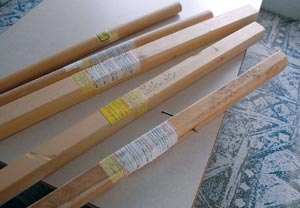Investigator hopes exhibit will show truth

(Courtesy photo - Navajo Police Department)
Protestors chase and attack two Navajo Nation Police officers northwest of Administration Building No. 1 during the riot of 1989 in Window Rock.
By Bill Donovan
Special to the Times
WINDOW ROCK, July 16, 2009

(Times photo - Paul Natonabah)
These two-by-two-by-three and 1/2 inch clubs were used by rioters during an attempt to takeover the financial building in Window Rock, resulting in the 1989 riot.
For Darrell Boye, memories of the 1989 riot in Window Rock are only a couple of feet away.
Boye, a criminal investigator for the Navajo Nation Police Department, is the custodian of the records of the riot.
But more than that, he has become a crusader in efforts to bring out the true facts concerning what happened on that day 20 years ago.
Among his collection of evidence are some of the two-by-fours that demonstrators - supporters of embattled Chairman Peter MacDonald Sr. - carried that day as they marched from the Keeto residence in Tse Bonito, N.M., to the tribal administration building north of the police station. Some of the clubs have nails protruding from them.
Boye also has all of the photographs - 432 in total - that were submitted in the federal trial of MacDonald and 11 of his supporters, all of whom were convicted of crimes in connection with the riot.
A few of the photographs appeared in local papers like the Gallup Independent and the Navajo Times but most of them have not had widespread distribution. Many were taken by demonstrators and confiscated by police after the riot. Some are shots taken from the video taken by police on that day.
The video shows demonstrators attacking police officers and putting them in plastic handcuffs they carried in their pockets.
It doesn't, however, show the shooting of the two MacDonald supporters - Arnold Begay of Red Mesa, Ariz., and Jimmy Dixon of Indian Wells, Ariz. - who died that day from gunshot wounds during the fight with police officers.
At the time of the shooting, the camera is following a police officer as he is being chased by demonstrators down a ravine.
"You can hear the shots in the background," Boye said.
Some of the photos show the shooting victims on the ground after they were shot. There are also photos of Ashkie Bahe, a MacDonald supporter who had the right side of his face damaged when a shotgun blast went off near his face.
He also has the police video and it, along with some of the photographs, were part of a Law Enforcement Day celebration that was held a couple of years ago.
What he wants is to make all of this - the photos, the video and even the clubs - part of an exhibition that Navajo people will be able to see so they can learn first-hand what actually happened that day.
The distortions began almost immediately after the riot with demonstrators talking to news media in the aftermath claiming that the violence was caused by police overreaction.
It continued the next day with MacDonald holding a press conference demanding a federal investigation into the shootings and justice for those that were injured.
But what has sometimes been forgotten over the years, he said, was that several police officers were injured - one was shot - and a number were terrorized by the crowd before calm was restored.
That's what the video and the photos show and that's the message he has been trying to get before the Navajo people.
But it hasn't been easy, he said, because even now, 20 years later, sentiments still run high whenever the riot is brought up. For that reason, attempts to get an exhibit of the photos, video and evidence used in the trial has been impossible to schedule.
"It's still a political football," he said, adding that he has been to three museums in this area and all three have turned down the exhibit.
He hasn't given up, however, and he's now looking at creating a Web site so that people can see the video and the photographs and judge for themselves what happened and who is to blame.
He's turned over the video to McKinley County officials who are in the process of digitizing it so it can be put on the Internet.

